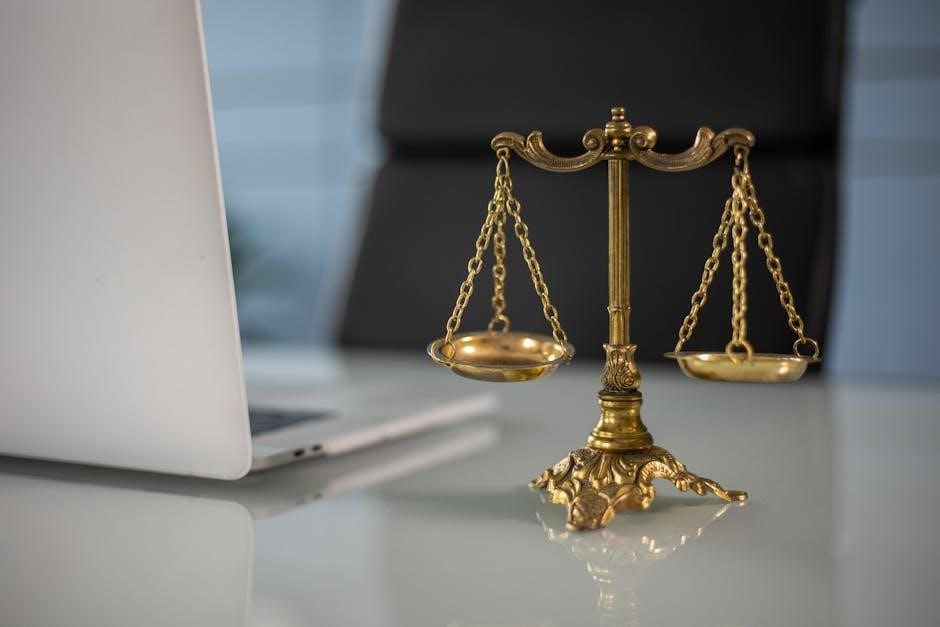The Supreme Court Nominations Worksheet is an educational tool designed to engage students in understanding the nomination process through interactive activities and discussions, highlighting its civic importance.
1.1 Overview of the Worksheet
The Supreme Court Nominations Worksheet is a structured educational resource designed to guide students through the complexities of the nomination process. It includes activities, discussions, and quizzes to enhance understanding. The worksheet covers key steps, from the President’s nomination to Senate confirmation, and incorporates elements like public opinion and media influence. Students engage in simulations, such as background checks and financial disclosures, to mimic real-world scenarios. This interactive approach fosters critical thinking and civic awareness, making it an invaluable tool for classroom learning.
1.2 Importance of Understanding Supreme Court Nominations
Understanding Supreme Court nominations is crucial for civic education, as it shapes the judiciary’s role in interpreting laws and upholding the Constitution. The process reflects the balance of power between the Executive and Legislative branches. By studying nominations, students gain insights into political dynamics, legal principles, and the impact of judicial decisions on society. This knowledge fosters informed citizenship and highlights the significance of civic engagement in shaping the nation’s legal framework and democratic system.

The Supreme Court Nomination Process
The Supreme Court nomination process involves the President selecting a nominee, Senate confirmation, and background checks. It ensures transparency and accountability in appointing justices.
2.1 Constitutional Basis for Nominations

The constitutional basis for Supreme Court nominations is rooted in Article II, Section 2 of the U.S. Constitution, granting the President the power to appoint justices. The “Advice and Consent” clause requires Senate confirmation, ensuring a balance of executive and legislative powers. This framework establishes a structured process for selecting justices, promoting accountability and transparency. The Constitution’s provisions outline the roles of both branches, safeguarding judicial independence while maintaining democratic checks and balances.
2.2 Role of the President in Nominations
The President plays a central role in Supreme Court nominations by selecting a nominee whose ideology aligns with their administration’s goals. They consider factors like judicial philosophy, experience, and political impact. The President also vets candidates through background checks and consultations with advisors. Once a nominee is chosen, the President formally announces the nomination, initiating the confirmation process. This role underscores the President’s influence in shaping the judiciary and reflects their responsibility to appoint qualified individuals who align with constitutional values.
2.3 Role of the Senate in Confirmation
The Senate plays a crucial role in the confirmation process of Supreme Court nominees. After the President submits a nomination, the Senate holds confirmation hearings to evaluate the nominee’s qualifications, judicial philosophy, and fitness for the role. The Senate Judiciary Committee conducts background checks, reviews financial disclosures, and assesses the nominee’s legal expertise. Following these hearings, the full Senate votes on confirmation. This process ensures transparency and accountability, allowing the Senate to either approve or reject the nominee based on their suitability for the Supreme Court.
Key Sections of the Worksheet
The worksheet includes historical context, landmark cases, and a nomination activity, providing students with a comprehensive understanding of the Supreme Court’s role and its significant decisions.
3.1 Historical Context of Supreme Court Nominations
The worksheet explores the historical evolution of Supreme Court nominations, highlighting landmark cases and significant rulings that have shaped the Court’s role. It examines how nominations have reflected political and social changes over time, emphasizing the impact of past decisions on current legal frameworks. By analyzing historical patterns, students gain insight into how the Court has balanced individual rights with governmental powers, illustrating the enduring influence of its rulings on American society and governance.
3.2 Landmark Cases and Their Impact
Landmark Supreme Court cases, such as Brown v. Board of Education and Roe v. Wade, have profoundly shaped legal and societal landscapes. These decisions address fundamental rights, influencing future rulings and public discourse. The worksheet highlights how such cases reflect the Court’s evolving interpretation of the Constitution, demonstrating its role in resolving critical national issues. By analyzing these cases, students understand the Court’s power to impact civil liberties, equality, and justice, fostering a deeper appreciation for its influence on American law and society. This section emphasizes the enduring legacy of these landmark rulings.
3.3 The Nomination Activity
The nomination activity simulates the Supreme Court appointment process, engaging students in critical thinking and civic education. It begins with the President selecting a nominee, followed by Senate confirmation hearings. Students analyze the nominee’s qualifications, ethical considerations, and public opinion. The activity includes completing a nomination table, discussing answers, and reflecting on the impact of their decisions. This interactive exercise aligns with the worksheet’s goals, fostering a deeper understanding of the nomination process and its significance in shaping the judiciary. It encourages collaboration and informed discourse among participants.
Answering the Worksheet Questions
Answering the worksheet questions involves understanding the constitutional basis of nominations, the role of the FBI in background checks, and financial disclosure requirements, fostering critical thinking and civic awareness.
4.1 Where is the Power to Appoint Justices Located?
The power to appoint Supreme Court justices is granted to the President in Article II, Section 2 of the U.S. Constitution. This provision outlines the President’s authority to nominate candidates for the Supreme Court, ensuring a clear separation of powers. The Constitution explicitly states that the President “shall nominate, and by and with the Advice and Consent of the Senate, shall appoint… Judges of the supreme Court.” This foundational principle establishes the executive branch’s role in initiating the nomination process, while the Senate plays a crucial role in confirmation, balancing executive authority with legislative oversight.
4.2 The Role of the FBI in Background Checks
The FBI plays a critical role in conducting thorough background checks on Supreme Court nominees. These investigations gather information on a nominee’s personal and professional history, including any potential ethical or legal issues. The FBI’s findings are compiled into a confidential report, which is then shared with the White House and the Senate Judiciary Committee. This process ensures that nominees are vetted for suitability and integrity, helping to inform the Senate’s confirmation decision. The FBI’s involvement adds a layer of transparency and accountability to the nomination process.
4.3 Financial Disclosure Requirements
Supreme Court nominees are required to complete financial disclosure forms, revealing their income sources, assets, and liabilities. This step ensures transparency and helps identify potential conflicts of interest. The disclosures are reviewed by the Senate Judiciary Committee to assess the nominee’s financial integrity and independence. This process is crucial for maintaining public trust in the judiciary and ensuring that justices are free from financial influences that could impact their decisions. The financial disclosure is a key part of the vetting process, alongside FBI background checks and public scrutiny.

The Significance of Supreme Court Nominations
Supreme Court nominations shape the judiciary’s direction, influencing laws and societal values. They reflect political priorities and public opinion, impacting the legal landscape for generations.
5.1 Political Implications of Nominations
Supreme Court nominations are a powerful political tool, reflecting the ideologies of the President and Senate. They often spark intense debate, as they shape the Court’s future direction. The process is deeply strategic, with political parties and special interest groups heavily influencing outcomes. Controversial nominations can polarize the nation, highlighting the nomination’s role in broader political strategies and power dynamics. This underscores the significant impact of nominations on the judiciary and the country’s legal framework.
5.2 Public Opinion and Media Influence
Public opinion and media play a significant role in shaping the narrative around Supreme Court nominations. Media coverage often amplifies debates, influencing how the public perceives nominees. This heightened scrutiny can sway political strategies, as both parties aim to align with popular sentiment. The worksheet activities, such as simulating confirmation hearings, help students understand how public opinion and media dynamics impact the nomination process, fostering critical thinking about the interplay between democracy and judicial appointments.
5.3 The Role of Special Interest Groups
Special interest groups significantly influence Supreme Court nominations by lobbying for or against nominees. These groups often align with political ideologies or specific agendas, using campaign contributions and media campaigns to sway public and senatorial opinions. Their efforts can shape the nomination process, as senators may consider their constituents’ and donors’ preferences. The worksheet highlights how these groups’ activities can impact the judiciary’s independence, emphasizing the need for transparency and accountability in maintaining the integrity of the nomination process.

The Worksheet as an Educational Tool
The worksheet serves as an interactive learning resource, engaging students through activities and discussions to deepen their understanding of the Supreme Court nomination process and its significance.
6.1 Engaging Students in Civic Education
The worksheet is a hands-on tool that fosters civic engagement by simulating real-world scenarios, such as nominating justices and debating confirmations. It encourages students to explore the Constitution, the role of the President and Senate, and the impact of Supreme Court decisions. Through activities like completing nomination tables and discussing answers, students gain a deeper understanding of the judicial system. This interactive approach helps students develop critical thinking and civic awareness, preparing them to participate in democratic processes. The worksheet bridges theory with practical application, making learning dynamic and meaningful.
6.2 Simulating the Nomination Process
The worksheet allows students to simulate the Supreme Court nomination process, acting as President or Senate members. They evaluate nominees, debate qualifications, and vote on confirmations. This hands-on approach helps students understand the political dynamics and constitutional roles involved. By mimicking real-world scenarios, including public opinion and media influence, the simulation fosters critical thinking and civic awareness. It bridges academic concepts with practical experience, enabling students to grasp the complexities of the nomination process and its significance in shaping the judiciary.

6.3 Encouraging Critical Thinking
The worksheet encourages critical thinking by engaging students in analyzing real-world scenarios and ethical dilemmas related to Supreme Court nominations. Through activities like debates and simulations, students evaluate evidence, weigh competing interests, and form well-reasoned opinions. This fosters deeper understanding of the nomination process and its implications. By challenging students to think critically about legal, political, and social issues, the worksheet prepares them to engage thoughtfully in civic discourse and decision-making, fostering lifelong skills in analysis and problem-solving.

Case Studies and Examples
The worksheet includes real-life examples of Supreme Court nominations, allowing students to analyze notable nominees and controversial cases, providing insights into the nomination process and its significance.
7.1 Notable Supreme Court Nominees
The worksheet highlights notable Supreme Court nominees, such as Ruth Bader Ginsburg and Brett Kavanaugh, whose nominations sparked significant debate. These examples illustrate the political and social dynamics surrounding appointments, offering insights into how nominees’ backgrounds and ideologies shape the Court’s direction. By analyzing these cases, students gain a deeper understanding of the nomination process and its impact on the judiciary. This section encourages critical thinking about the role of the Supreme Court in American society and the factors influencing its composition.
7.2 Controversial Nominations in History
Historically, some Supreme Court nominations have sparked intense controversy, such as Robert Bork’s rejection in 1987 and Clarence Thomas’s contentious confirmation in 1991. These cases highlight ideological divides and personal conduct concerns. The worksheet examines how such nominations reflect broader societal tensions and political strategies. By studying these examples, students understand the complexities of the nomination process and its susceptibility to partisan influence. These controversies underscore the high stakes involved in shaping the Court’s future and its impact on American law and society.
7.3 Modern-Day Nomination Challenges
Modern Supreme Court nominations face unique challenges, including heightened political polarization, intense media scrutiny, and evolving societal expectations. The process often becomes a battleground for ideological control, with nominees facing rigorous vetting. Financial disclosure requirements and FBI background checks add layers of complexity. Additionally, public opinion and special interest groups play significant roles in shaping outcomes. These challenges highlight the need for transparency and fairness, making the nomination process a focal point of contemporary political debate and civic engagement.
The Role of the Judiciary Committee
The Judiciary Committee oversees Supreme Court nominations, conducting thorough confirmation hearings and evaluations. Their decisions significantly impact the nomination process and the Court’s composition.
8.1 Overview of the Committee’s Responsibilities
The Judiciary Committee plays a crucial role in the Supreme Court nomination process. It reviews the nominee’s background, conducts confirmation hearings, and evaluates their qualifications. The committee gathers feedback from various stakeholders, including the FBI and legal experts, to assess the nominee’s suitability. This thorough process ensures that only qualified candidates proceed to a full Senate vote. The committee’s decisions significantly influence the Court’s composition and the judiciary’s future direction, making their role both pivotal and impactful in shaping the legal landscape. Their work is essential for maintaining judicial integrity and public trust.
8.2 The Confirmation Hearing Process
The confirmation hearing process involves the Judiciary Committee conducting public sessions to question the nominee; Senators inquire about the nominee’s legal philosophy, judicial experience, and stance on key issues. The nominee must demonstrate qualifications and address concerns. Public opinion and media scrutiny intensify during this phase. After hearings, the committee votes to advance or reject the nomination. This process ensures transparency and accountability, allowing the Senate to assess the nominee’s suitability for a lifetime appointment to the Supreme Court, impacting the nation’s legal framework and future rulings.
8.3 The Impact of Committee Decisions
The Judiciary Committee’s decisions significantly influence the Supreme Court nomination process. A favorable vote advances the nominee to the full Senate, while a negative vote can halt or delay confirmation. Committee decisions also set precedents for future nominations, shaping how the Senate evaluates candidates. Public perception and political dynamics are heavily influenced by these outcomes, as they reflect the balance of power and ideological priorities in Congress. Ultimately, the committee’s role ensures scrutiny and accountability, impacting the Court’s composition and the nation’s legal landscape for years to come.

The Future of Supreme Court Nominations
The future of Supreme Court nominations may involve reforms, increased transparency, and the integration of technology to enhance accountability and public engagement in the process.

9.1 Potential Reforms to the Process
Potential reforms to the Supreme Court nomination process include term limits for justices, expanded financial disclosure requirements, and stricter ethics guidelines. These changes aim to enhance transparency and accountability, ensuring the process remains fair and impartial. Additionally, proposals to modify the confirmation process to reduce partisanship and increase public engagement have been discussed. Such reforms could modernize the system, addressing contemporary challenges while maintaining the integrity of the judiciary.
9.2 The Role of Technology in Nominations
Technology plays a crucial role in modern Supreme Court nominations by enhancing transparency and engagement. Online platforms provide real-time updates on the nomination process, allowing the public to track developments. Digital tools facilitate the distribution of educational materials, such as the Supreme Court nominations worksheet, enabling widespread access. Additionally, technology supports interactive simulations of the nomination process, helping students and citizens understand the complexities involved. These innovations foster a more informed and participatory civic environment, ensuring the process remains accessible and engaging for all stakeholders.
9.3 Ensuring Transparency and Accountability
Transparency and accountability are vital in Supreme Court nominations to maintain public trust. The process involves public hearings, financial disclosures, and FBI background checks, ensuring nominees are thoroughly vetted. The Senate’s role in confirmation hearings provides a platform for scrutiny, while media coverage and public opinion add layers of accountability. These measures ensure that the nomination process remains open and fair, fostering confidence in the judiciary’s independence and integrity. Transparency also involves clear communication of the nominee’s qualifications and potential conflicts of interest, ensuring a well-informed decision-making process.
The Supreme Court Nominations Worksheet offers a comprehensive understanding of the nomination process, fostering civic awareness and critical thinking about the judiciary’s role in democracy.

10.1 Summary of Key Points
The Supreme Court Nominations Worksheet provides a detailed exploration of the nomination process, emphasizing its constitutional roots and the roles of the President and Senate. It highlights the importance of civic engagement, financial disclosures, and FBI background checks; Through interactive activities, students gain insights into historical context, landmark cases, and the political implications of nominations. The worksheet encourages critical thinking about the judiciary’s impact on democracy, fostering a deeper understanding of the legal system and its significance in shaping the nation’s future.
10.2 Final Thoughts on the Importance of Civic Engagement
Civic engagement is vital for a functioning democracy, as it fosters informed participation in governance. Understanding Supreme Court nominations empowers individuals to hold leaders accountable and shape the judiciary’s role. Public opinion and media influence highlight the need for active citizenship. By engaging with educational tools like the worksheet, students develop critical thinking skills, preparing them to navigate complex legal and political landscapes. Civic responsibility ensures the judiciary reflects societal values, safeguarding justice and equality for future generations.
